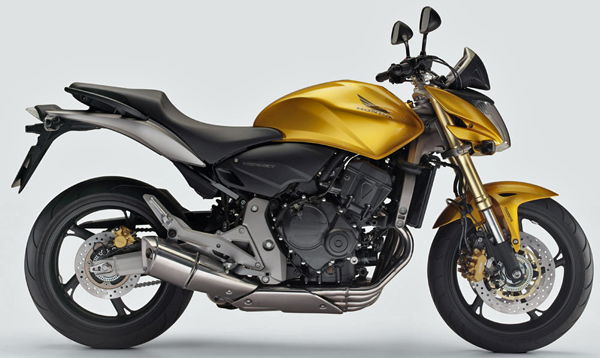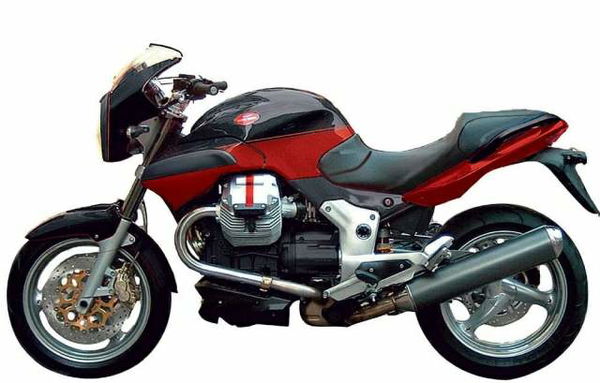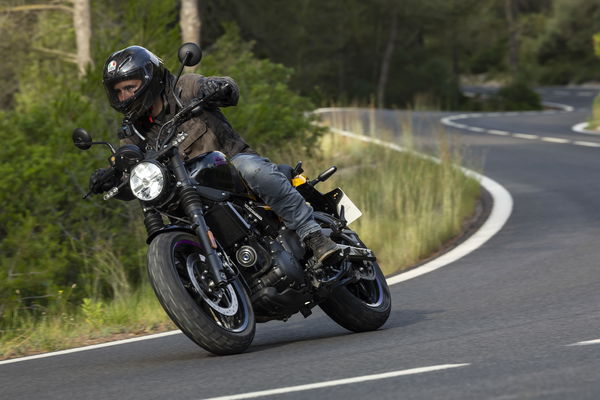CB600F Hornet (2007 - present) review
Neat, quick, and well-thought out update for a firm favourite

Honda's top-selling naked middleweight gets a top-to-toe revamp, sharp new looks and the world's ugliest exhaust collector box.
Japanese bikes don't come much more Italian than the revamped Hornet 600. Despite the name on its tank, the Hornet was shaped by Honda's European design studio in Italy, and built at the factory in Atessa. Given Italian sales were largely responsible for the original Hornet 600 topping European sales charts from 2001 to 2003, there's no doubt plenty of this latest version will remain in Italy too.
But Brits have also bought plenty of Hornets since the original was launched nine years ago. This latest update is the most comprehensive yet, combining a reworked 16-valve engine from the latest CBR600RR with an aluminium frame instead of the old steel one. The result is a bike that produces a claimed 100bhp and weighs 173kg, giving it 5bhp on its predecessor with 5kg less to cart about into the bargain.
Those Euro-stylists did a good job, retaining the Hornet identity while adding an edge with features including the piggy-back headlight, reworked tank and seat, and a new four-into-one exhaust whose diagonal downpipes bring to mind Honda's CB400F four from the mid-70s. Unfortunately the Hornet has to get through Euro3, so also has an ugly chamber alongside, holding the catalytic converter.
Honda has tried hard to make the Hornet feel special, with features including the sharply shaped instrument panel, which incorporates a digital speedo and analogue tacho. The reduced weight helped make the bike feel pleasantly manageable, as did the generous steering lock that allowed effortless slow-speed manoeuvring as we left the launch-base hotel, near Faro on Portugal's Algarve coast, out onto winding roads that headed up into the hills.
The motor felt sharp and responsive, and also emitted a fruity rasp from the stubby, MotoGP-style silencer near my right boot. Midrange torque is a key requirement of any naked bike, especially a middleweight, and Honda has given the Hornet a fairly generous helping despite its engine's connections with the sporty CBR600RR. The Hornet has some handy extra grunt thanks to injection and exhaust changes, plus a few internal mods.
Predictably there was plenty of life at the top end, too. By 7000rpm the Hornet was really moving, then at about 10 grand it kicked again as the tacho needle shot towards the 13,000rpm redline. On the motorway the Honda whirred up to an indicated 140mph while I braced my neck against the wind; at lower speeds the instrument panel gave a bit of wind protection, but cruising at much above 80mph got uncomfortable pretty quickly.
High-speed stability was flawless, and back on twistier roads I was impressed by the Hornet's handling. The bike's light weight and fairly sporty geometry meant it could be cranked into a bend with minimal effort. Suspension worked well given the units' relative simplicity, which gives scope only for preload adjustment of the rear shock, with no adjustment of the 41mm upside-down forks.
The Hornet jarred slightly over broken road surfaces, and certainly couldn't be described as luxurious. But on our relatively short ride it was reasonably comfortable thanks partly to the thin but broad dual seat, which incorporates a pair of grab-handles for a pillion. Riders planning long distances though would be advised to fit the flyscreen available as an accessory, as are a pillion seat cover (matched to paint options of yellow, blue, red and black), rear hugger, heated grips and tank bag.
The launch bikes' front brake blend of 296mm discs and four-piston calipers worked well. But after rain had arrived to make the roads slippery, one rider touched his front brake in an attempt to avoid a stray dog, and locked his front wheel. As he slid along the ground he had time to wish he'd been riding the ABS/CBS equipped version of the Hornet that will be sold alongside this basic model.
The availability of the ABS-equipped version hints at one reason for the Hornet's success: its appeal to a broad cross-section of riders. Despite the lack of wind-protection, it's reasonably practical. There's no centre-stand, and the mirrors are Italian-bike narrow, but detailing and build quality seem up to Honda's high standard. The enlarged fuel tank holds 19 litres, enough for over 150 miles between refills.
The old Hornet was quick, light, agile, easy to ride, good-looking and reasonably priced. This model is an improvement in those first five categories, and at £5495 for the ABS/CBS version it's decent value for money too. (The standard-braked version will follow in July, for about £300 less.) Expect to see the Hornet back near the top of the sales charts soon.
VERDICT 4/5
Neat, quick, and well-thought out update for a firm favourite
Honda's top-selling naked middleweight gets a top-to-toe revamp, sharp new looks and the world's ugliest exhaust collector box.
Japanese bikes don't come much more Italian than the revamped Hornet 600. Despite the name on its tank, the Hornet was shaped by Honda's European design studio in Italy, and built at the factory in Atessa. Given Italian sales were largely responsible for the original Hornet 600 topping European sales charts from 2001 to 2003, there's no doubt plenty of this latest version will remain in Italy too.
But Brits have also bought plenty of Hornets since the original was launched nine years ago. This latest update is the most comprehensive yet, combining a reworked 16-valve engine from the latest CBR600RR with an aluminium frame instead of the old steel one. The result is a bike that produces a claimed 100bhp and weighs 173kg, giving it 5bhp on its predecessor with 5kg less to cart about into the bargain.
Those Euro-stylists did a good job, retaining the Hornet identity while adding an edge with features including the piggy-back headlight, reworked tank and seat, and a new four-into-one exhaust whose diagonal downpipes bring to mind Honda's CB400F four from the mid-70s. Unfortunately the Hornet has to get through Euro3, so also has an ugly chamber alongside, holding the catalytic converter.
Honda has tried hard to make the Hornet feel special, with features including the sharply shaped instrument panel, which incorporates a digital speedo and analogue tacho. The reduced weight helped make the bike feel pleasantly manageable, as did the generous steering lock that allowed effortless slow-speed manoeuvring as we left the launch-base hotel, near Faro on Portugal's Algarve coast, out onto winding roads that headed up into the hills.
The motor felt sharp and responsive, and also emitted a fruity rasp from the stubby, MotoGP-style silencer near my right boot. Midrange torque is a key requirement of any naked bike, especially a middleweight, and Honda has given the Hornet a fairly generous helping despite its engine's connections with the sporty CBR600RR. The Hornet has some handy extra grunt thanks to injection and exhaust changes, plus a few internal mods.
Predictably there was plenty of life at the top end, too. By 7000rpm the Hornet was really moving, then at about 10 grand it kicked again as the tacho needle shot towards the 13,000rpm redline. On the motorway the Honda whirred up to an indicated 140mph while I braced my neck against the wind; at lower speeds the instrument panel gave a bit of wind protection, but cruising at much above 80mph got uncomfortable pretty quickly.
High-speed stability was flawless, and back on twistier roads I was impressed by the Hornet's handling. The bike's light weight and fairly sporty geometry meant it could be cranked into a bend with minimal effort. Suspension worked well given the units' relative simplicity, which gives scope only for preload adjustment of the rear shock, with no adjustment of the 41mm upside-down forks.
The Hornet jarred slightly over broken road surfaces, and certainly couldn't be described as luxurious. But on our relatively short ride it was reasonably comfortable thanks partly to the thin but broad dual seat, which incorporates a pair of grab-handles for a pillion. Riders planning long distances though would be advised to fit the flyscreen available as an accessory, as are a pillion seat cover (matched to paint options of yellow, blue, red and black), rear hugger, heated grips and tank bag.
The launch bikes' front brake blend of 296mm discs and four-piston calipers worked well. But after rain had arrived to make the roads slippery, one rider touched his front brake in an attempt to avoid a stray dog, and locked his front wheel. As he slid along the ground he had time to wish he'd been riding the ABS/CBS equipped version of the Hornet that will be sold alongside this basic model.
The availability of the ABS-equipped version hints at one reason for the Hornet's success: its appeal to a broad cross-section of riders. Despite the lack of wind-protection, it's reasonably practical. There's no centre-stand, and the mirrors are Italian-bike narrow, but detailing and build quality seem up to Honda's high standard. The enlarged fuel tank holds 19 litres, enough for over 150 miles between refills.
The old Hornet was quick, light, agile, easy to ride, good-looking and reasonably priced. This model is an improvement in those first five categories, and at £5495 for the ABS/CBS version it's decent value for money too. (The standard-braked version will follow in July, for about £300 less.) Expect to see the Hornet back near the top of the sales charts soon.
VERDICT 4/5
Neat, quick, and well-thought out update for a firm favourite











